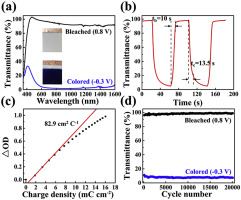Nano Energy ( IF 16.8 ) Pub Date : 2019-12-03 , DOI: 10.1016/j.nanoen.2019.104350 Yongji Yao , Qi Zhao , Wei Wei , Zhang Chen , Yong Zhu , Pan Zhang , Zongtao Zhang , Yanfeng Gao

|
In the past decades, as an alternative to traditional sputtering deposition process, atmospheric pressure solution-based deposition (APSD), considered as a cost-effective method for the construction of nanostructured electrochromic (EC) films with improved EC performance, is widely studied. However, the inadequate EC performance of the films, especially the poor cycle stability, impedes the development of solution-processed EC films. This paper reports excellent EC performance results for WO3 quantum-dots films prepared by a common APSD process with either Li+ or Al3+ electrolyte: a large optical contrast (97.8% and 94.1% at 633 nm), a fast switching speed (4.5 s and 13.5 s for coloring, 4 s and 10 s for bleaching) and an ultralong cycle life (10000 cycles with 10% optical contrast loss and 20000 cycles without degeneration at 633 nm). The excellent EC performance can be attributed to the ultrasmall size in all three-dimensions and no organic overlayer of WO3 quantum dots,which would greatly shorten the diffusion paths of intercalation ions, decrease interface barrier, provide fast charge-transport and electron-transfer kinetics and high reaction rates. Trivalent Al3+, as an alternative to common monovalent insertion ions (H+, Li+, Na+), was proven to be as an effective insertion ion for WO3 quantum dots. Compared with Li+ electrolyte, the films possess longer cycle life in Al3+ electrolyte, which can be attributed to the smaller ionic radius and the ability to support multi-electron redox reactions of Al3+. This research is an important first step for the fabrication of inexpensive EC smart windows, and should shape the future research on solution-based processes.
中文翻译:

WO 3量子点电致变色
在过去的几十年中,作为传统溅射沉积工艺的替代方法,基于大气压力溶液的沉积(APSD)被认为是一种具有成本效益的方法,用于构建具有改进的EC性能的纳米结构电致变色(EC)膜。然而,膜的EC性能不足,尤其是差的循环稳定性,阻碍了溶液加工的EC膜的发展。本文报道了通过采用Li +或Al 3+的常规APSD工艺制备的WO 3量子点薄膜的优异EC性能结果。电解质:大的光学对比度(在633 nm时为97.8%和94.1%),快速的切换速度(用于着色的4.5 s和13.5 s,用于漂白的4 s和10 s)和超长的循环寿命(10000循环,光学含量为10%)对比度损失和20000次循环,并且在633 nm处没有退化。优异的EC性能归因于所有三个维度上的超小尺寸,并且没有WO 3量子点的有机覆盖层,这将大大缩短嵌入离子的扩散路径,降低界面势垒,提供快速的电荷传输和电子转移动力学和高反应速率。三价Al 3+,作为常见单价插入离子(H +,Li +,Na +)被证明是WO 3量子点的有效插入离子。与Li +电解质相比,该膜在Al 3+电解质中具有更长的循环寿命,这归因于较小的离子半径和支持Al 3+的多电子氧化还原反应的能力。这项研究是制造便宜的EC智能窗户的重要的第一步,并且应该塑造基于解决方案的工艺的未来研究。

















































 京公网安备 11010802027423号
京公网安备 11010802027423号